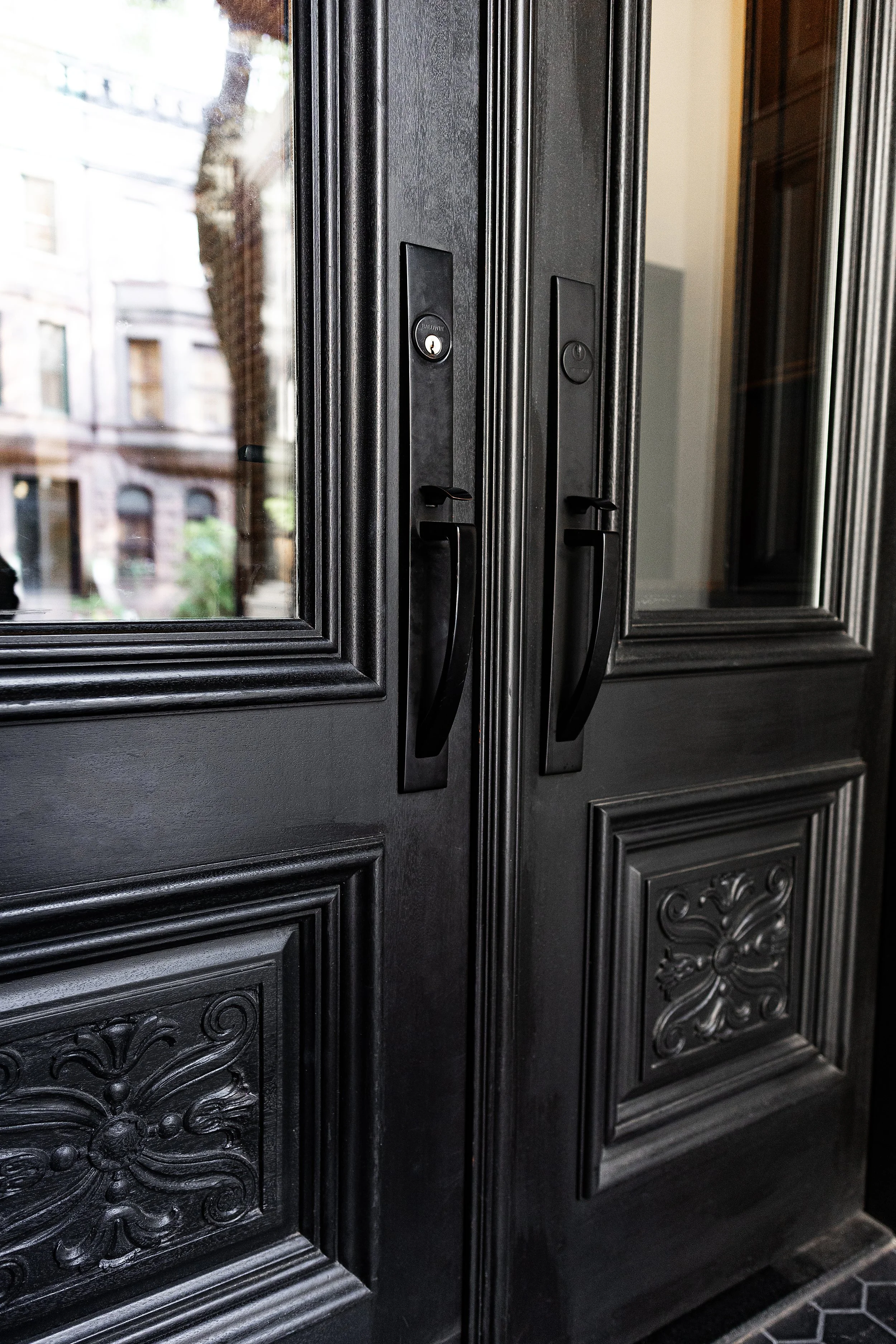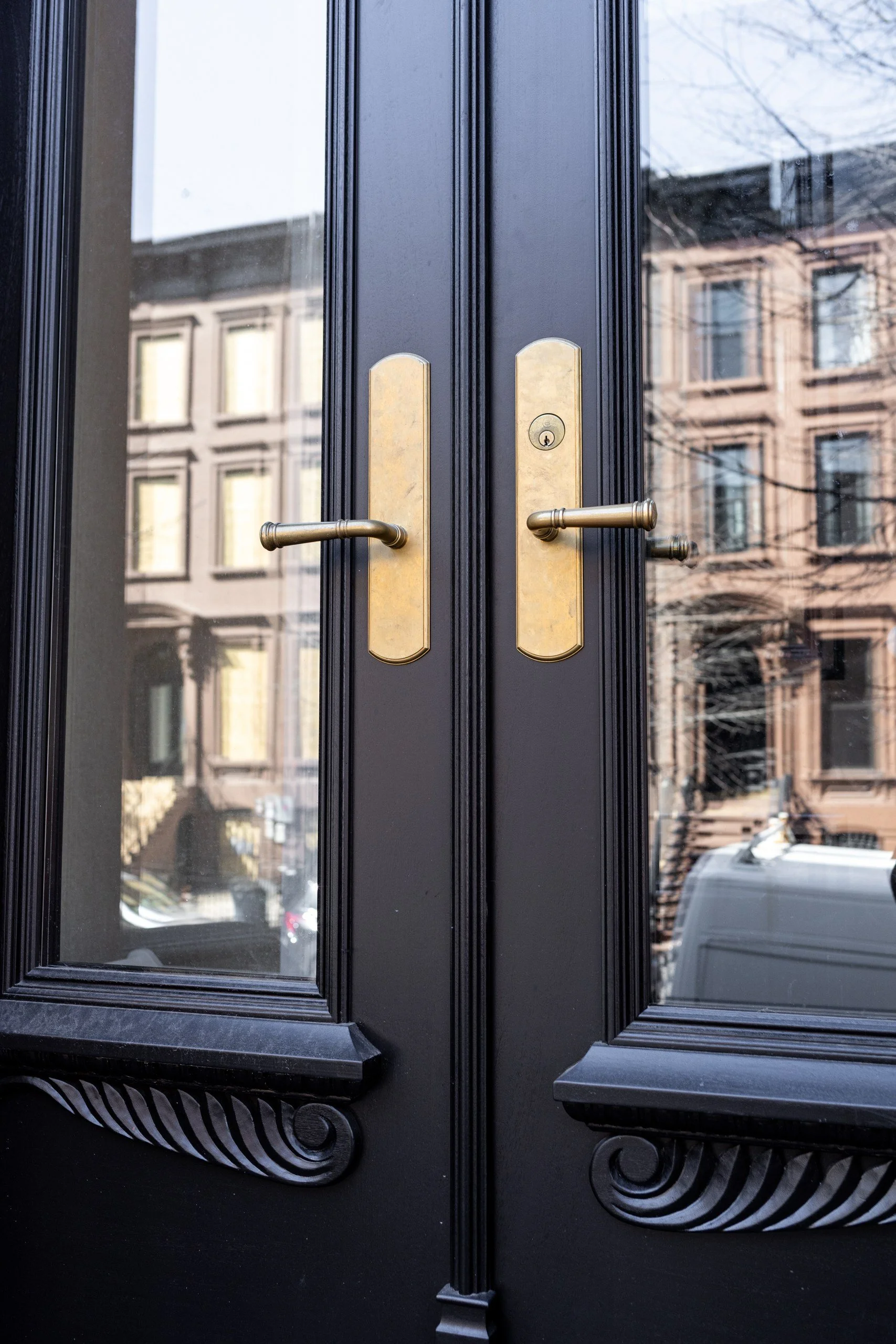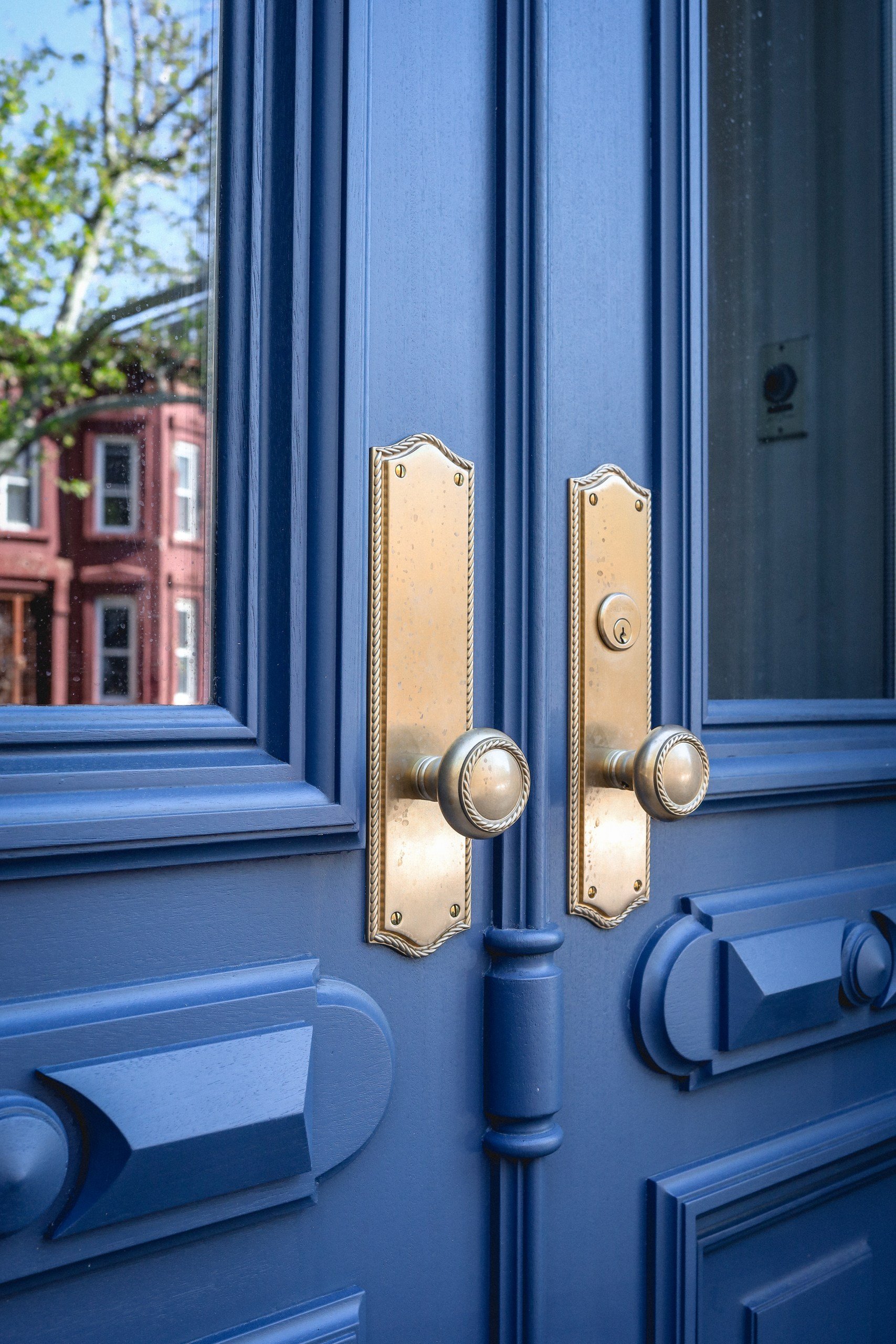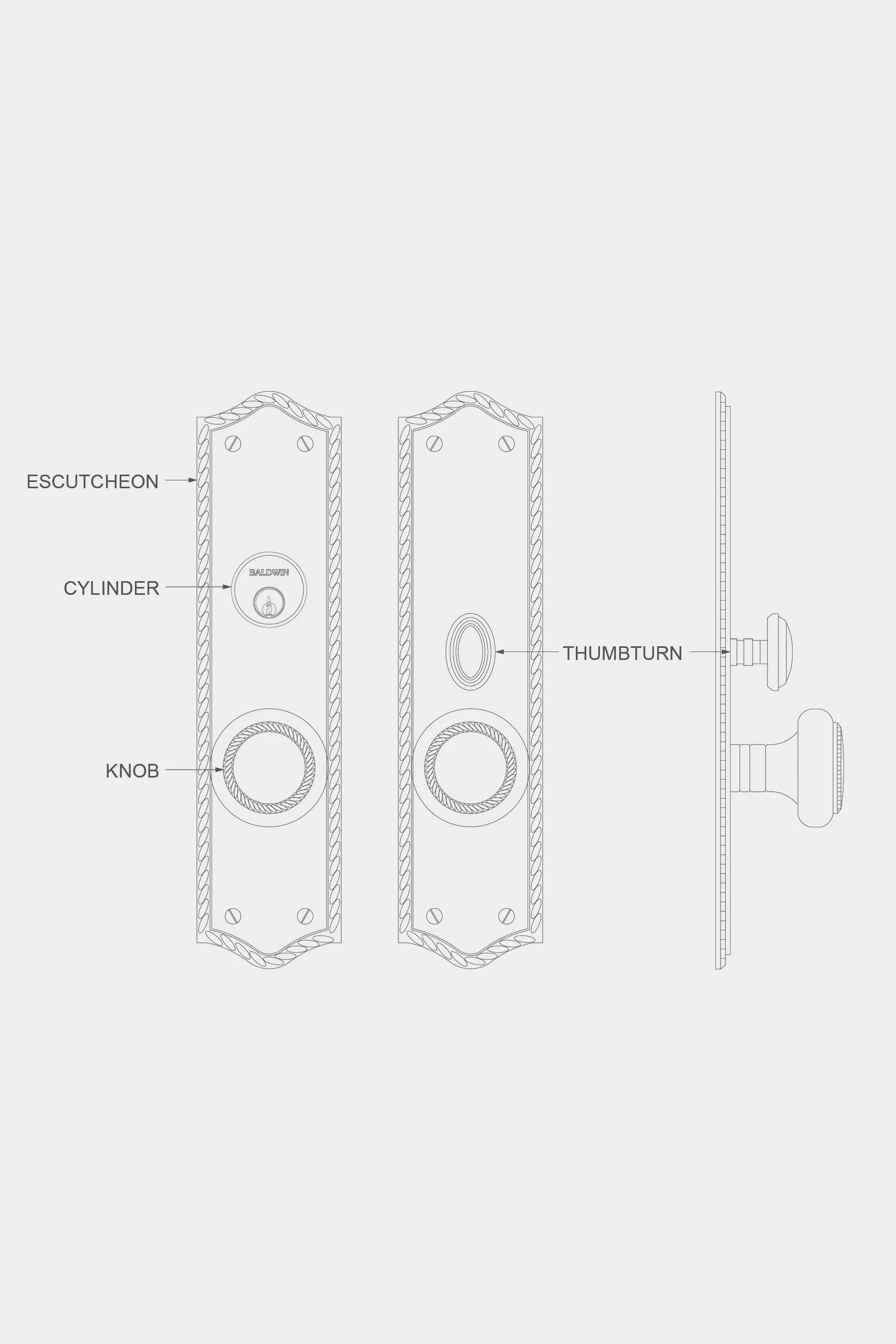Thumbpiece, Lever, or Knob?
How to Choose the Right Door Hardware for Your Building's Entry Door?
Front doors do a lot of heavy lifting in a residential building—and so does the hardware. At Brownstone Door Co., we help building owners and co-op boards choose hardware that feels good in the hand, holds up under daily use, and complements the architecture.
By “hardware,” we mean more than just locks. It’s the handle, thumbpiece or knob, lever, and decorative backplates. On multi-residential entry doors, this hardware isn’t simply decorative; it’s a fixture used dozens of times a day by residents, staff, deliveries, and guests. That’s why we guide our clients toward options that strike a balance between durability, accessibility, and appearance.
So how do you choose the right one? Let’s walk through the three main types:
1. Thumbpiece Handleset
Baldwin Lakeshore hardware in a black finish paired with custom mahogany entry doors featuring a hand-carved panel motif.
Diagram of Baldwin Lakeshore hardware showing thumbpiece handleset with cylinder, escutcheon, handle, and interior lever.
A thumbpiece handleset consists of a grip-style handle and a thumb latch. From the outside, you unlock the door with a key, then press down on the thumbpiece to release the latch and open the door.
This is the type we most often recommend for multi-residential buildings, and here’s why:
It’s more durable over time, especially in high-traffic environments
The grip is comfortable and intuitive to use
It’s designed to withstand daily wear better than traditional knobs
The visual profile is elegant and versatile
We usually specify a lever on the interior for ease of use, while on the exterior, a thumbpiece handleset offers better durability under daily wear and integrates more naturally with landmark-style entries.
We’ve installed this configuration in co-ops and multi-unit buildings across NYC and found it to perform well for residents of all ages. While we often recommend thumbpiece latch hardware for multi-residential properties, it’s equally suitable for single-family homes. And importantly, it looks great on a landmark-appropriate, custom wood door.
2. Lever Handleset
Classic Brass Chautauqua entrance lever set in an unlacquered brass finish, installed on custom mahogany black-finished doors with detailed mouldings.
Diagram of the Classic Brass Chautauqua entrance lever set showing cylinder, escutcheon, lever, and interior thumbturn.
A lever is exactly what it sounds like—a straight or curved handle that you push down to release the latch. On exterior doors, it’s typically paired with a keyed lock above.
Levers are known for being user-friendly and ADA-compliant. They don’t require a tight grip or wrist twist, which makes them easier to use for older adults, people with arthritis, or anyone carrying groceries or pushing a stroller.
We typically specify a lever on the interior side of the door for precisely this reason—it offers ease of use for residents exiting the building.
3. Traditional Doorknob
Baldwin Barclay hardware in a satin brass finish paired with custom mahogany entry doors finished in Benjamin Moore Newburyport Blue.
Diagram of Baldwin Barclay hardware in a knob trimset showing escutcheon, cylinder, knob, and interior thumbturn.
The doorknob is the classic round handle most people are familiar with. It requires a full twist of the wrist to operate and is typically spring-loaded. While knobs are widely available and visually familiar, they tend to present more issues in shared residential settings.
Here’s what we’ve observed over time:
Knobs tend to loosen more quickly under frequent use
The twist motion can be difficult for older residents or those with reduced hand strength
They’re less ergonomic than levers or thumbpieces
In high-traffic buildings, they often require early replacement or ongoing maintenance
That’s why we don’t typically recommend it for main entry doors in multi-family buildings.
Entry Door Hardware Frequently Asked Questions
Which door hardware is better for accessibility and older residents?
Lever handles are widely considered the most accessible option. They don’t require a tight grip or wrist twist, which makes them easier to use for older adults, people with arthritis, or anyone carrying groceries. A lever can be opened with an elbow, or even one finger.
Is a thumbpiece handleset difficult for residents to use?
Not really. While a thumbpiece requires two actions - unlocking with a key and pressing the latch to open the door - the grip is intuitive.
Do knobs make sense for building entry doors?
Knobs are the most traditional option and may feel familiar, but they present challenges in multi-residential settings. The twisting motion can be difficult for older residents or anyone with reduced hand strength, and knobs tend to loosen more quickly under heavy use.
A knob trim set is best suited for smaller-scale residential properties, such as one-family homes. For larger buildings, thumbpieces and levers perform better and last longer.
So What Do We Recommend?
Based on years of experience, here’s the configuration that’s worked best for our clients:
A thumbpiece handleset on the exterior, for its balance of durability, comfort, and appearance
A lever on the interior, for ease of use and accessibility
A knob for one-family residences.
Door Hardware Manufacturers We Recommend
When you order a custom-made entry door, the hardware is just as important as the door itself. While there are endless options online, a handful of manufacturers have stood the test of time, offering durable construction, timeless styles, and finishes that elevate any entry.
These are the names we turn to most often because they combine durability, beautiful design, and finishes that complement historic properties.
Baldwin – A widely respected name in architectural hardware, Baldwin offers a broad range of classic and modern styles with solid brass construction. Reliable, versatile, and backed by a strong warranty.
Classic Brass – Known for precision machining and fine detailing, Classic Brass specializes in traditional American hardware patterns and hand-applied finishes. Ideal if you're looking for something traditional yet refined.
P.E. Guerin – Founded in 1857, P.E. Guerin is America’s oldest decorative hardware company, producing intricate, hand-cast bronze pieces still made in their New York City foundry. Ideal for landmark projects.
E.R. Butler & Co. – Renowned for its custom hardware and exacting standards, E.R. Butler produces elegant trim with refined proportions and museum-quality finishes, often specified for high-end residential projects.
Still not sure which door hardware to choose?
That’s completely normal. Most people don’t spend their day thinking about door hardware—we do that for you. Our team guides clients through the selection process with consultations, specific recommendations, and visual tools such as line drawings or renderings to illustrate how the hardware will look on their doors.
Does your historic property need a new door?
Contact us to learn more about our services.






